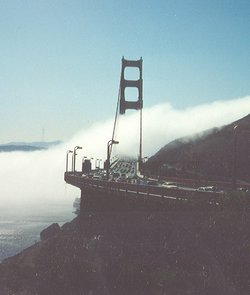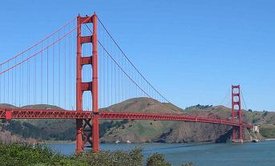Golden Gate Bridge
|
|
The Golden Gate Bridge is a suspension bridge spanning the Golden Gate, the opening into the San Francisco Bay from the Pacific Ocean. It connects the city of San Francisco on the northern tip of the San Francisco Peninsula and a portion of the south-facing Marin County headlands near the small bayside town of Sausalito, and is located at Template:Coor dm. The bridge is 1.22 miles (1970 m] long, the distance between the towers ("main span") is 4200 feet (1280 m), and their height is 746 feet (230 m) above the water.
The bridge was the brainchild of Joseph Strauss, an engineer responsible for over 400 drawbridges, though they were far smaller than this project and mostly inland. Strauss spent over a decade drumming up support in Northern California. Strauss's initial proposal for this location was not at all pretty[1] (http://www.lib.berkeley.edu/news_events/exhibits/bridge/up028.html), being comprised of a massive cantilever on each side connected with a central suspension segment. Other key figures in the bridge's construction include architect Irving Morrow, responsible for the Art Deco touches and the choice of color, and engineer Charles Alton Ellis and bridge designer Leon Moisseiff, who collaborated on the complicated mathematics.
Golden_Gate_Bridge_from_underneath.jpg
The construction of the bridge began on January 5, 1933 under the aegis of the Works Projects Administration (WPA), a program instigated by Franklin D. Roosevelt to create public works through federal funds and alleviate the effects of the Great Depression. Strauss, a graduate of the University of Cincinnati placed a brick from his alma mater's demolished McMicken Hall in the south anchorage before the cement was poured. The bridge was completed in April 1937 and opened to pedestrians on May 27 of that year. The next day, President Roosevelt pushed a button in Washington, DC signaling the start of vehicle traffic over the Bridge. The cost to build it was $27 million. A unique aspect of the construction of this bridge was that a safety net was set up beneath it, significantly reducing the number of deaths that were typical for a construction project such as this in the early 1900s. Approximately 11 men were killed from falls during construction, and approximately 19 men were saved by the safety net. Most of the deaths occurred near completion when the net itself failed under the stress of a scaffold fall. Workers whose lives were saved by the safety nets became proud members of the (informal) Halfway to Hell Club.
The center span was the longest among suspension bridges until 1964 when the Verrazano Narrows Bridge was erected between the boroughs of Staten Island and Brooklyn in New York City. The Golden Gate Bridge also had the world's tallest suspension towers at the time of construction, and retained that record until more recently. In 1957, Michigan's Mackinac Bridge surpassed the Golden Gate Bridge's length between anchorages to become the world's longest suspension bridge in total length. The longest center suspension span in the world is currently the Akashi-Kaikyo Bridge in Japan.
As the only road to exit San Francisco to the north, the bridge is part of both United States Highway 101 and California State Route 1. The bridge has six total lanes of vehicle traffic, and walkways on both sides of the bridge. The median markers between the lanes are moved to conform to traffic patterns. On weekday mornings, traffic flows mostly southbound into the city, so four of the six lanes run southbound. Conversely, on weekday afternoons, four lanes run northbound. While there has been much demand and discussion concerning the installation of a movable barrier, no satisfactory solution has been committed to by the authorities. Usually, the eastern walkway is for pedestrians only, and the western walkway is for bicyclists only, although this can change during times of construction. Both walkways are closed to pedestrian traffic during the evening and at night.
On September 1, 2002, the toll for Southbound motor vehicles was raised from $3.00 to $5.00. Northbound motor vehicle traffic, cycling, and pedestrian traffic remain toll free.
Golden_Gate_Bridge_2003.jpg
Aesthetics
The color of the bridge is orange vermilion, deemed International Orange. The color was selected by consulting architect Irving Morrow because it blends well with the natural surroundings yet enhances the bridge's visibility in fog.
The bridge is widely considered one of the most beautiful examples of bridge engineering, both as an structural design challenge and for its aesthetic appeal. It was declared one of the modern Wonders of the World by the American Society of Civil Engineers. According to Frommer's travel guide, the Golden Gate Bridge is "possibly the most beautiful, certainly the most photographed, bridge in the world." [2] (http://www.frommers.com/destinations/sanfrancisco/A25170.html) (although Frommers also bestows the "most photographed" honor on Tower Bridge [3] (http://www.frommers.com/destinations/london/A29870.html))
Ggb_by_night_rotated.jpg

Suicides
Jumping from the bridge is a rather common method to commit suicide. On average, there is one jump every two weeks, with a total of over 1,300 suicides (the official count ended in 1995 when the number approached 1,000). More suicides take place on this bridge than on any other single structure in the world. [4] (http://www.suicidereferencelibrary.com/test4~id~1380.php) Almost all people jump facing east, towards the bay, due largely to the fact that only the eastern side of the bridge is open to pedestrians. The 220-foot (67 m) fall takes four seconds and jumpers hit the water at 75 miles per hour (120 km/h). As of 2003, only 26 people have survived the jump. The survivors, many of whom report that they regretted the decision in mid-air, all struck the water feet first at a small angle and suffered multiple internal injuries and broken bones. In 2005, documentarian Eric Steel revealed that he had tricked the bridge committee into allowing him to film the bridge for months and had captured nearly 20 suicides on tape. A famous fictional example of an attempted suicide is seen in Vertigo.
The bridge board has for decades resisted calls to add a suicide-prevention barrier to the four-foot (1.2 m) tall rail. However, on February 24, 2005, the bridge committee took the first steps towards approving a roughly $2 million barrier plan [5] (http://sfgate.com/cgi-bin/article.cgi?file=/n/a/2005/02/25/state/n000942S60.DTL).
The Golden Gate Bridge in fiction and film
- The bridge is a prominent backdrop in Alfred Hitchcock's film Vertigo (1958) in a scene set just east (bayside) of Fort Point, with the bridge in the background.
- The bridge is seen prominently in the opening sequence of the soap opera Love is a Many Splendored Thing, which was set in San Francisco.
- The bridge plays a significant role in the climactic scene of the James Bond film A View to a Kill (1985).
- In The Core, deadly microwaves from the sun break through the magnetic field and melt the bridge before frying the rest of San Francisco.
- In Superman, Superman saves a school bus about to fall from the bridge.
- In the Japanese science fiction film Mothra, the bridge is destroyed by the collision of a large nuclear mutant monster.
- In Hulk, the Hulk jumps off the bridge to save a fighter jet.
- In the Star Trek universe, Starfleet Headquarters and Starfleet Academy are located in San Francisco's Presidio, with a view of the Golden Gate Bridge. Instead of a direct view of traffic lanes and whatever transportation technology is employed, there is an obscuring weatherproof glass arch cover. Perhaps everyone travels the bridge by walking and bicycle in this future time, since purposeful travel may be done quickly by the transporter technology common in starships. In Star Trek IV: The Voyage Home, the Klingon bird-of-prey used by the crew of the Starship Enterprise flies under the Golden Gate Bridge on its way to crashing into the Bay. Later, in Star Trek: Deep Space Nine, the Golden Gate Bridge is destroyed during the Dominion War in an attack by the Breen on San Francisco.
- In George of the Jungle George climbs and strolls on the Golden Gate Bridge as if it were his beloved jungle, and rescues a stranded worker.
- In Charmed, scenes of the Golden Gate Bridge can be seen.
- In Dirty Harry, "Scorpio" hijacks a school bus full of children and forces the driver to head North across the bridge.
- In The West Wing, a terrorist attempt to blow up the Golden Gate Bridge sparks a plot line involving the US assassination of the Qumari intelligence minister (who masterminded the plot to blow up the bridge).
- In the TV movie 10.5, an earthquake destroys the bridge.
- The bridge is seen in the opening credits, and in other cut shots, of the popular television show Full House, which aired on ABC from 1987-1994.
- In the video game series Grand Theft Auto (series), the bridge is featured in one of the cities. It is possible to jump off the bridge, but the player will die when s/he does so.
External links
- The Official website of the Golden Gate Bridge (http://www.goldengate.org/)
- Structurae: Golden Gate Bridge (http://en.structurae.de/structures/data/index.cfm?id=s0000029)
- The Museum of San Francisco (http://www.sfmuseum.net/)'s Story Behind the Construction of the Span (http://www.sfmuseum.net/hist10/ggbridging.html)
- PBS American Experience (http://www.pbs.org/wgbh/amex/goldengate/index.html)
- Golden Gate Bridge Virtual Tour (http://www.virtuar.com/ysf2/golden_gate_bridge.htm)
- The story of Golden Gate Bridge (http://www.cbsforum.com/cgi-bin/articles/partners/cbs/search.cgi?template=display&dbname=cbsarticles&key2=golden&action=searchdbdisplay) - by CBS Forum (http://www.cbsforum.com/)
- Photographs of the Golden Gate Bridge (http://www.lodgephoto.com/galleries/usa/goldengatebridge/)
- Photos of the Golden Gate Bridge (http://www.terragalleria.com/california/california.sf-golden-gate-bridge.html)
Template:Geolinks-US-hoodscale Template:Geolinks-US-colorphoto Template:Geolinks-US-surrounds
References
- Tad Friend: Jumpers: The fatal grandeur of the Golden Gate Bridge, The New Yorker, Oct 13, 2003 v79 i30 page 48bg:Голдън Гейт
da:Golden Gate-broen de:Golden Gate Bridge fr:Golden Gate Bridge ja:ゴールデンゲートブリッジ nl:Golden Gate brug pl:Most Golden Gate pt:Golden Gate Bridge ru:Золотые Ворота (мост) fi:Golden Gate Bridge sv:Golden Gate-bron zh:金门大桥

